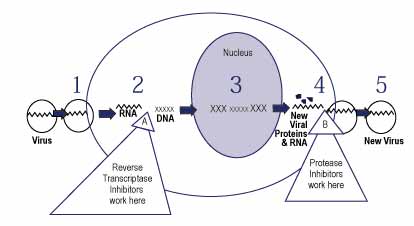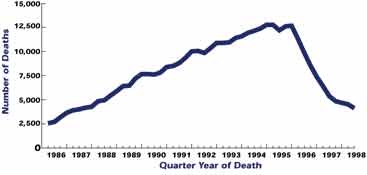New Treatments for HIV Infection:
Prolonging and Improving Life
When AIDS was first recognized in 1981, patients with the disease were unlikely
to live longer than a year or two. Today, advances in understanding the
human immunodeficiency virus (HIV) and how it causes AIDS have helped scientists
to develop an effective arsenal of drugs that, when used in combination,
can help many people with HIV disease live longer and healthier lives. The
addition of a new class of anti-HIV drugs to combination therapies has contributed
to the first drop in the U.S. AIDS death rates since the beginning of the
epidemic. (See the graph on AIDS death rates.) The story of this achievement
highlights the pivotal contributions of both basic research and the Institute's
collaborations with academia and industry to develop effective treatments
for HIV disease.
Since HIV was identified in 1983, NIAID-supported scientists have led efforts to understand how the virus attacks the immune system and causes disease. This research demonstrated that substantial amounts of HIV are present, primarily in the lymphoid tissue, from the earliest stages of infection; that levels of HIV typically increase as HIV disease progresses; and that HIV remains infectious and actively replicates even while trapped and hidden in immune cells. Such basic research discoveries provide the rationale for using drugs that delay or prevent HIV disease by suppressing HIV replication.
Early Anti-HIV Treatments
For several years, the only drugs available for treating HIV infection
were nucleoside analogue reverse transcriptase (RT) inhibitors. These
drugs interfere with the action of a specific HIV enzyme (RT) involved
in the replication cycle of HIV. The first anti-HIV drug, zidovudine (AZT),
was originally developed in 1964 as a possible cancer treatment but was
found to be ineffective against tumor cells. However, collaboration between
the National Cancer Institute and the pharmaceutical company Burroughs
Wellcome led to the discovery in the early 1980s of AZT's ability to suppress
HIV replication in the test tube and paved the way for clinical trials
of AZT.
Burroughs Wellcome, with input from NIH and the Food and Drug Administration, successfully conducted testing of AZT in HIV-infected individuals. Subsequently, NIAID's AIDS Clinical Trials Group (ACTG) conducted several clinical trials in partnership with industry to test four other nucleoside RT inhibitors: zalcitabine (ddC), didanosine (ddI), stavudine (D4T), and lamivudine (3TC). All five drugs are now licensed in the United States. Additional ACTG studies demonstrated the benefits of AZT therapy for preventing mother-to-infant transmission of HIV and for lowering the risk for developing AIDS in persons with HIV infection.
Unfortunately, HIV rapidly develops resistance to these and other anti-HIV drugs. Researchers have attacked the problem of drug resistance-which is particularly harmful because of HIV's high rate of replication and mutation-by using regimens of multiple anti-HIV drugs. NIAID-supported researchers were among the first to show (in 1995) that treatment with combinations of AZT and other nucleoside analogue RT inhibitors was more effective than treatment with AZT alone. In addition, combining 3TC with AZT slowed the virus from developing resistance to AZT and, in some cases, restored AZT sensitivity in patients who carried virus that had become resistant to the drug. As a result of these NIAID-supported studies, combination therapy emerged as the preferred treatment modality for HIV infection.
A New Class of Anti-HIV Drugs
Meanwhile, basic research supported by NIAID and others was providing
information about additional mechanisms of HIV replication that offered
new targets for anti-HIV drugs. For example, Institute-supported basic
research was pivotal to discovering and defining the importance of the
HIV protease enzyme, which is used by the virus to produce infectious
HIV particles. Other Institute-supported scientists helped determine the
precise three-dimensional structure of HIV protease, a crucial step in
designing drugs that block the action of the enzyme. NIAID also supported
researchers who helped drug-screening efforts by developing simple, rapid
tests to measure the inhibition of protease activity. Many of these basic
research advances were made by investigators of NIAID's National Cooperative
Drug Discovery Groups for Treatment of HIV program, which encourages collaboration
among scientists from academia, industry, and government.
These accomplishments set the stage for the Institute's successful collaboration with the pharmaceutical industry in developing the new class of anti-HIV drugs known as protease inhibitors. Building on these findings, NIAID actively promoted the protease enzyme as a potential target for drug development and supported pharmaceutical companies' initial drug discovery efforts throughout the late 1980s and early 1990s. The Institute worked closely with several industrial partners as they designed, produced, and clinically tested protease inhibitors. This collaboration helped speed product development. The first licensed protease inhibitor went to market in December 1995. Additional protease inhibitors were approved in 1996 and 1997.
| Anti-HIV Drugs
The diagram above shows (1) the virus entering the cell, (2-3) conversion of viral RNA to DNA using the enzyme reverse transcriptase and incorporation of the viral genome into the DNA of the host cell, (4) viral proteins cleaved by protease for assembly of new viral particles, (5) new virus particles budding from the surface of the host cell. It also shows the steps in the viral life cycle that are interrupted by (A) reverse transcriptase inhibitors and (B) protease inhibitors. |
Potent Combination Therapies
Because two-drug combination therapy was proven more effective than monotherapy,
the next logical step was to test three-drug combinations that included
the new protease inhibitors. Since 1996, several NIAID-supported research
groups and collaborating pharmaceutical companies reported that triple-drug
combinations with a protease inhibitor reduced the levels of HIV circulating
in the blood so dramatically that the virus often was undetectable with
standard tests. In papers published in September 1997, investigators supported
by the Institute conclusively demonstrated that triple-drug combinations
with a protease inhibitor and two other anti-HIV drugs were more effective
than one- or two-drug regimens for long-term suppression of HIV.
| AIDS Deaths in the United States from
January 1986 to June 1998
Estimates Adjusted for Reporting
Delays The increased use of potent combinations of anti-HIV drugs has
led to a significant decline in AIDS deaths in the United States
in the past 2 years. |
New Avenues for Therapies
The success in many patients of the new combination therapies, when used
according to Federal guidelines, has been encouraging, at least in the
short term. These heartening results, however, are not the end of the
story. HIV's ability to mutate and become resistant to currently available
drugs is a persistent threat, and many patients do not benefit from or
cannot tolerate complex combination regimens. NIAID is supporting research
to develop more potent therapies that have fewer toxic effects and are
easier to administer. Also crucial are less expensive treatments for the
more than 30 million persons worldwide who are infected with HIV.
| Spinoffs From NIAID Research on HIV/AIDS
NIAID basic and clinical research on HIV/AIDS has contributed to "spinoff" advances in other areas of research. Information about viruses, infectious microbes, and the immune system gleaned from HIV/AIDS research is providing insights on new ways to fight other diseases.
|
These concerns underscore the need for NIAID's continued effort to find new therapies for HIV infection. Basic researchers at NIAID laboratories have helped explain why HIV can rebound in patients who discontinue combination therapy, and they are working to develop new ways to attack pools of latently infected cells that serve as hiding places for HIV. NIAID scientists also have opened new avenues for therapies with the discovery of coreceptors for HIV's entry into immune cells. (See Chemokines and HIV Coreceptors)
Since 1993, NIAID's Strategic Program for Innovative Research on AIDS
Treatment (SPIRAT) has supported basic and clinical research on novel
approaches to treatment. Scientists supported by SPIRAT and other NIAID
research programs are contributing to the discovery and development of
the next generation of anti-HIV treatments. Such strategies may include
therapies that combat drug resistance by targeting a broader range of
mechanisms in the HIV replication cycle, treatments designed to rebuild
the damaged immune system of infected individuals, and gene therapy to
protect cells from HIV infection or interfere with HIV function in already
infected cells. NIAID also plays a central role in international efforts
to develop an HIV vaccine. As the story of the AIDS epidemic continues
to unfold, NIAID research will continue to provide the foundation for
new breakthroughs in improving the quality and duration of life for people
infected with HIV.
Contents | Previous | Next | Last
Publications Home | NIAID Home | NIAID Search
Last Updated, May 25, 1999 (ldr)

